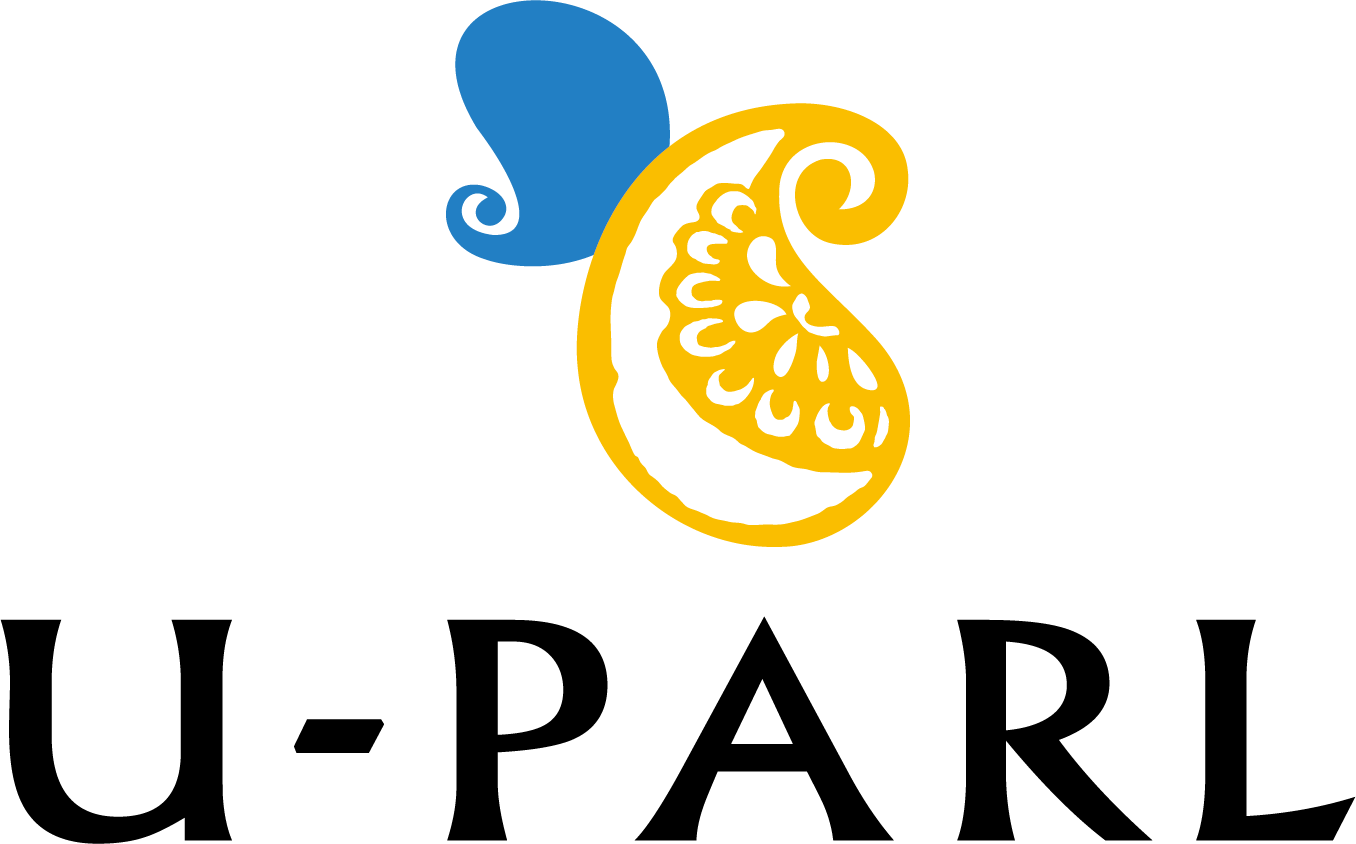Yumio SAKURAI (桜井由躬雄1945-2012) was a distinguished scholar of historical area studies and a Professor Emeritus of the University of Tokyo. The Yumio SAKURAI collection comprises 2,112 pieces and is currently housed in the Asian Research Library of the University of Tokyo Library System. While the core of this collection consists of books in Vietnamese related to the history of Vietnam, the collection also contains materials on the society and culture of Vietnam and other regions of Southeast Asia. For details on Sakurai’s research life, refer to his autobiography, Hitotsu no Taiyō: Ōruweizu [A Sun: Always] (Mekong, 2013). Here, I would like to outline highlights of Sakurai’s research work based on the abovementioned autobiography and to elucidate the background for establishing this collection and its specifics.
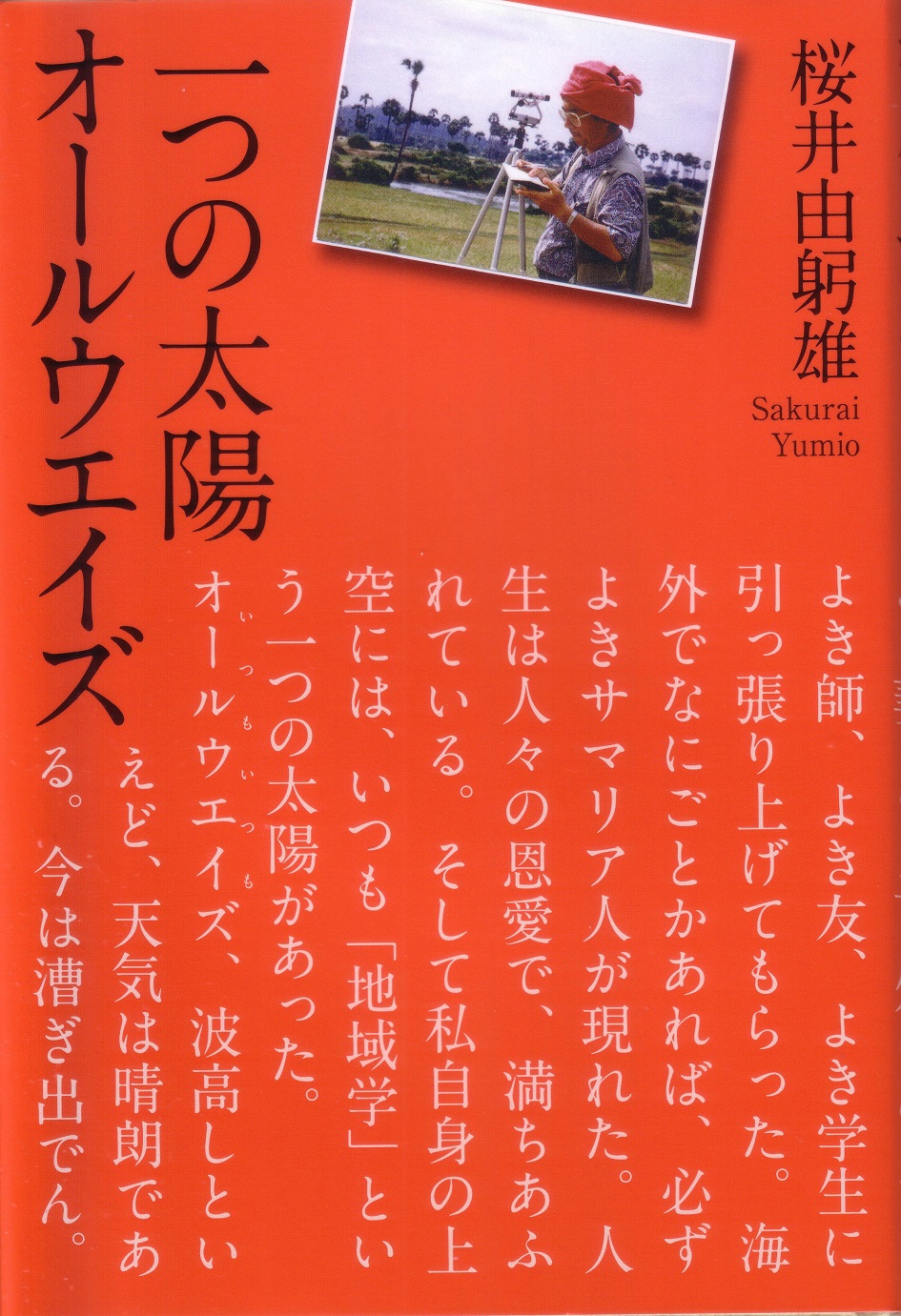 Prof. Sakurai’s autobiography, Hitotsu no Taiyō: Ōruweizu [A Sun: Always]
Prof. Sakurai’s autobiography, Hitotsu no Taiyō: Ōruweizu [A Sun: Always]
The text on the cover reads:
“I had good mentors, good friends, and good students who always pulled me up. Whenever something happened in a foreign country, a good Samaritan would always appear. Life is full of human warmth and love, and in the sky above me, there has always been one sun called ‘area studies.’ Even though the waves are always high, the weather is fine. I’m going to row out now.”
Sakurai’s research on Southeast Asia started with historical investigation of written sources in classical Chinese. In 1965, he entered the Department of Oriental History of the Faculty of Letters of the University of Tokyo, and from the time of preparation of his graduation thesis until leaving the Division of Oriental History of the Graduate School of Humanities in 1977, was pursuing research on the pre-modern history of Vietnam, with particular interest in the communal land system in the Red River delta in north Vietnam. That is why the Yumio SAKURAI Collection includes a lot of facsimile editions of Han-Nom books published in Vietnam.
Sakurai’s transfer to the Center for Southeast Asian Studies of Kyoto University in 1977 marked a turning point in his research. Through having participated in many broad-area general surveys as well as local village surveys in various regions of Southeast Asia and India during his career with the Center for Southeast Asian Studies, Kyoto University, a leading research institution of area studies on Southeast Asia, Sakurai conceived his vision for area studies based on a deep comprehension of the local environment through field observation, direct collection of source materials, and integration of diverse disciplines. At the same time, he continued studying the communal land system by incorporating in the research the methodology of area studies, and summed up the results of this work in Betonamu sonraku no keisei: sonraku kyoyuden = konden sei no shiteki tenkai. [The Formation of Villages in Vietnam: The Historical Development of the Cong dien System](By Yukio Sakurai. Japan: Sobunsha, 1987. [In Japanese]).
The second turning point was his two years’ experience serving as a Researcher and Advisor at the Embassy of Japan in Vietnam in 1985-1987. The Communist Party of Vietnam initiated full-fledged reforms called Đổi Mới (“Renovation”) at the Party’s 6th National Congress in December 1986, and Sakurai’s stay at Hanoi fell during the time from just before the new policy was announced till before the benign effect of the Đổi Mới policy on the economy began to emerge, or, in other words, the time when travelling between Japan and Vietnam as well as maintaining exchanges between researchers of the two countries was not easy. For details on the situation in Hanoi at that time, see Hanoi no yūutsu [Melancholy in Hanoi] (Mekong, 1989).
The Yumio SAKURAI Collection includes a lot of pieces published in the period from the 1950s through the 1980s that today are hard to obtain even locally in Vietnam. As for the subject matter, although the overwhelming majority of the materials comprising the Yumio SAKURAI Collection pertain to history, the collection includes materials dealing with a wide variety of topics related to Vietnam, such as agriculture, literature, politics, language, religion, folklore, stage performance arts, and music. As for the geographical coverage, the materials are not limited to the Red River delta in north Vietnam, there are also Gazetteers (địa chí in Vietnamese) and local histories, histories of Communist Party local branches for various provinces, districts, and communes across Vietnam (sources that are usually classified at Japanese libraries as “Local Materials”). Behind collecting these materials, in addition to Sakurai’s long-term stay in Hanoi as a Researcher and Advisor at the Embassy of Japan in Vietnam before the Đổi Mới policy started to take off, there seem to lie his ability to energetically build a wide academic network with local scholars during that period and maintain this network to his later years, as well as his aspiration to comprehensively understand Vietnam as a pioneer in the “Vietnamese studies.”
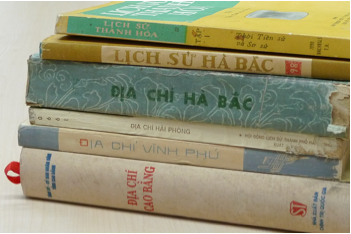 Vietnamese “Local Materials”
Vietnamese “Local Materials”
In 1990, Sakurai transferred from the Center for Southeast Asian Studies of Kyoto University to the Faculty of Letters of the University of Tokyo. With the abolishment of the system of travel permits for foreigners to travel within Vietnam in 1993, Sakurai began his long-term research project on Bách Cốc Village located in the low basin of the Red River delta in north Vietnam. The Bách Cốc Village research project earned high recognition in Vietnam, and in 2003 Sakurai was awarded the Friendship Medal (Huy chương hữu nghị) by the Socialist Republic of Vietnam and also received an Honorary Doctorate (Tiến sĩ danh dự) title from Vietnam National University, Hanoi (VNU). In 2009, he was conferred with the 2008 Vietnam Studies Prize of the Phan Châu Trinh Cultural Foundation. Moreover, in 2013, after he passed away, Sakurai was posthumously conferred with the Friendship Order (Huân chương Hữu nghị) by the Socialist Republic of Vietnam.
As the Bách Cốc Village research project was mainly based on interview surveys regarding household economy and interviewing the village elders with rather small geographical coverage, Bakkukokku: Rekishi-chiikigaku no kokoromi [Bách Cốc: An Introduction to Historical Area Study] (South and Southeast Asian History and Society Course, the Graduate School of Humanities and Sociology, The University of Tokyo, 2006) that summarizes research results as of 2006 does not incorporate many published sources On the other hand, the materials left in his study after his death prove that, while engaging in the almost 20-year-long Bách Cốc Village research project and a study on the history of the formation of Hanoi city, which will be touched upon below, Sakurai continued to widely collect books and periodicals published in Vietnam on diverse subjects related to this country.
Regarding the awards received one after another in the early 2000s, Sakurai himself took them as a symbol of appreciation in Vietnam for the Bách Cốc Village research project. However, at the same time, the materials left in his study upon his death reveal his aspiration to perceive Vietnam through works of Vietnamese researchers and through his exchanges with the people of this country with deep respect toward academic achievements accumulated in Vietnam, which suggests that this respectful and dedicated attitude must have also been recognized through these awards.
From the end of 2005, Sakurai studied the history of the formation of Hanoi city that involved a survey on information on monument inscriptions and an interview survey of elders, as well as the use of GIS. Then, after his retirement from the University of Tokyo in 2007, in his later years until he passed away in 2012, Sakurai’s main academic interest shifted from Bách Cốc Village research to the history of the formation of Hanoi city. On the other hand, Sakurai, by 2005 at the latest, began writing up Betonamu gaisetsu [Vietnam: An Introduction] (Mekong, expected to be published soon), a book that would summarize specific characteristics of various areas of Vietnam, and resumed a general landscape survey. Unfortunately, as Sakurai died unexpectedly in 2012 at the age of 67, his study on the history of the formation of Hanoi city was left unsummarized and Betonamu gaisetsu [Vietnam: An Introduction] became his last unfinished work. Such are the highlights of Sakurai’s research life and specifics of the Yumio SAKURAI Collection.
Regarding other pillars of Sakurai’s academic activities as important as his research on Vietnamese villages, there should be a mention of his translation, editing and authoring work for a number of general overview books on the history of Southeast Asia, such as Indoshina bunmeishi (the Japanese translation of Les peuples de la péninsule indochinoise: histoire, civilisations by George Cœdès. Co-translated with Noboru KARASHIMA and Akiko UCHIDA. MISUZU Shobo, 1969), Tōnan ajiashi. 1 [History of Southeast Asia.1], (Shinpan sekai kakkokushi. 5 [New Edition. Histories of Countries of the World. 5]. Yamakawa Shuppansha: 1999), Vetonamu kanbojia raosu [Vietnam, Cambodia, Laos], (Tōnan ajia gendaishi. 3 [Modern History of Southeast Asia. 3]. Yamakawa Shuppansha, 1997), Tōnan ajia sekai no keisei [Formation of Southeast Asian World] (“Bijuaru ban” sekai no rekishi, 12 [World History “Visual Edition,” 12]. Co-authored with Yoneo ISHII. Kodansha, 1985), Kome ni ikiru hitobito: taiyō no hagemashi mori to mizu no yasashisa [People Living on Rice: Encouragement of the Sun, Tenderness of the Forests and Water] (Photos by Tsugusato OHMURA. Shueisha, 2000), Tōnan ajia no rekishi [History of Southeast Asia] (Foundation for the Promotion of the Open University of Japan, 2002), Zenkindai no tōnan ajia [Pre-Modern Southeast Asia] (Foundation for the Promotion of the Open University of Japan, 2006). The majority of sources on various regions of Southeast Asia used for this work, particularly books in Japanese and European languages, are not included in the Yumio SAKURAI Collection of the Asian Research Library. This is because, in accordance with the will of the family and due to storage space limitations, the materials received as a donation by the Asian Research Library of the were, in principle, limited to published sources that were not yet in the possession of the University of Tokyo.
Also, non-published materials related to the Bách Cốc Village research project, such as copies of genealogies (gia phả) collected at the village and photos taken there, were inherited by the Bách Cốc Village research project team based at the Center for Southeast Asian Studies of Kyoto University.
As for journals and other such materials published in Vietnam, they will be bound and housed at the Asian Research Library together with journals collected by Motoo FURUTA that were also donated to the Asian Research Library.
The Yumio SAKURAI Collection was systematized and organized by the Uehiro Project for the Asian Research Library (U-PARL) of the University of Tokyo Library System during the 2014-2015 school years and by the end of the 2015 school year was donated to the Asian Research Library. OPAC registration work started in the 2019 school year. Tetsuro FUJIKURA (U-PARL Collaborative Researcher/Associate Professor at Aichi Prefectural University), Yuki SHIBUYA (U-PARL Project Research Fellow) and Shota SATO (PhD student at the Graduate School of Arts and Sciences) were in charge of the selection and organization process, the assets registration work involved the participation of the Section of Books Acquisition, Information Processing and Management Division, the University of Tokyo Library System.
Particularly in the 2014 school year, due to U-PARL’s facilities and equipment situation at the time of its start-up, most of the selection and organization work was conducted at Sakurai’s house. We would like to extend our deepest gratitude to Sakurai’s family, who kindly welcomed us into their house and let us carry out this work for more than a year and also implemented such measures as regularly airing the bookshelves to help keep the materials to be donated in good condition.
Yuki SHIBUYA (U-PARL Project Research Fellow)
8. Dec. 2020
(Last updated 10. Aug. 2021)
Note 1: The Yumio SAKURAI Collection is currently in the process of being registered in OPAC. (See details in OPAC)
Note 2: 【Past Article】 The Yumio SAKURAI Collection【In preparation】 (http://u-parl.lib.u-tokyo.ac.jp/wp/english/sakurai-collection)
【 Introductory Essay 】 Vietnam Statistical Yearbooks from the Yumio SAKURAI Collection
Tetsuro FUJIKURA (U-PARL Collaborative Researcher/Associate Professor at Aichi Prefectural University)
8. Dec. 2020
The source material introduced here is a collection of Vietnam Statistical Yearbooks for the period since the 1970s. Only a very small number of libraries in Japan, such as the Institute of Developing Economies Library, Kyoto University Center for Southeast Asian Studies Library and National Museum of Ethnology, have in their possession a complete collection of Vietnam Statistical Yearbooks starting with the 1970s. During his stay in Hanoi as a Researcher and Advisor at the Embassy of Japan in Vietnam in 1985-87, Sakurai was keen on collecting locally published books, which at that time were hard to obtain outside Vietnam. His collection also includes a lot of books that today are difficult to find even locally, mainly those published from the 1970s through the 1980s, such as literature works, histories of villages, studies on agricultural communes, and books related to the Communist Party.
Looking through the Statistical Yearbooks arranged chronologically will reveal a fascinating story of the developments in the economic situation in Vietnam of each particular period. Even after the Vietnam War ended in 1975, Vietnam, remaining under an economic blockade by Western countries, suffered severe economic conditions due to the failed domestic economic policy and intervention in the Cambodian conflict. Particularly from the late 1970s, the country’s economy fell into a deep recession. Such developments in the economic situation are reflected even in the quality of the books’ paper. While the new course on economic reforms known as Đổi Mới (“Renovation”) that was launched in earnest in 1986 managed to improve the economic situation by the beginning of the 1990s, it was not until 1996-97 that the cheap acidic paper (which deteriorates over time due to the acid it contains resulting in the books printed with it weakening and becoming brittle) was changed for the neutral paper, which is more expensive but suitable for prolonged storage of the books. Among the items on display, the neutral paper is used for printing the Statistical Yearbooks for the years starting with 1996 (published in 1997).
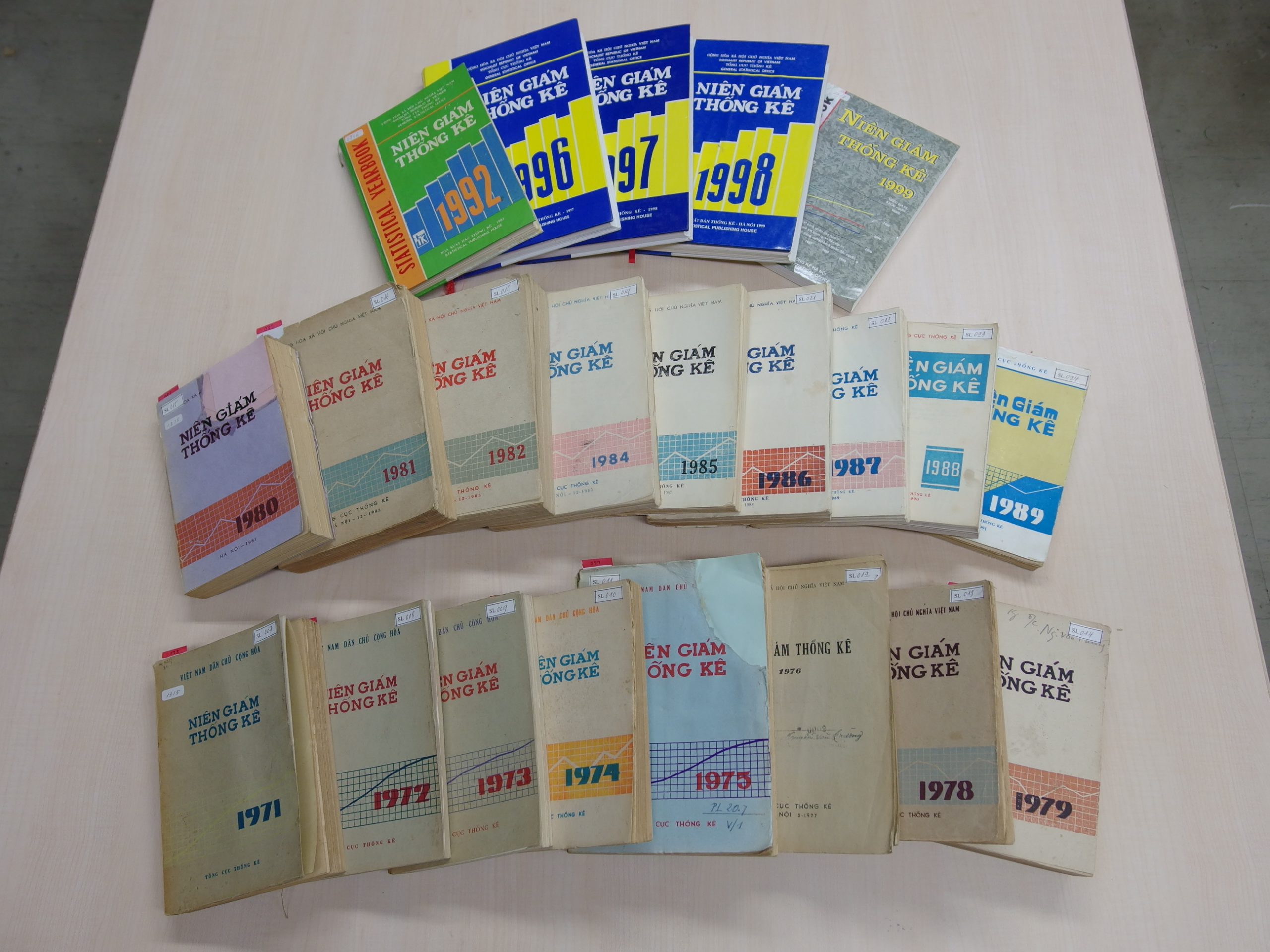 Statistical materials for the years 1971 to 1999
Statistical materials for the years 1971 to 1999
Furthermore, the prices on the books in Sakurai’s collection reveal evidence of the denomination carried out on September 14, 1985 (with 1 new dong equaling 10 old dong) (see the photos). The reason behind this denomination lay in the hyperinflation caused by the failure of the wage-price reform. The prices of books with a similar number of pages and of a similar format and shape before and after 1985 differ by about ten times.
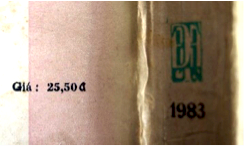 Indication of “price 22.50 dong” (History of Vietnam published in 1983)
Indication of “price 22.50 dong” (History of Vietnam published in 1983)
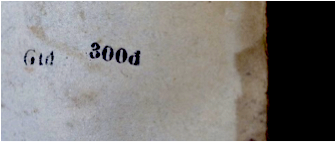 Indication of “price 300 dong” (Chronological Ancient and Medieval History of Vietnam published in 1987)
Indication of “price 300 dong” (Chronological Ancient and Medieval History of Vietnam published in 1987)
(This source material introduction, which presents a partially revised explanatory description of the collection on display within the handouts “Summary of Presentation and Description of Collection on Display” distributed at the 1st U-PARL Symposium “Connecting to a Widening Asia — Looking toward the Construction of a New Asian Research Library” held on January 31, 2015, was posted on September 30, 2020.)
